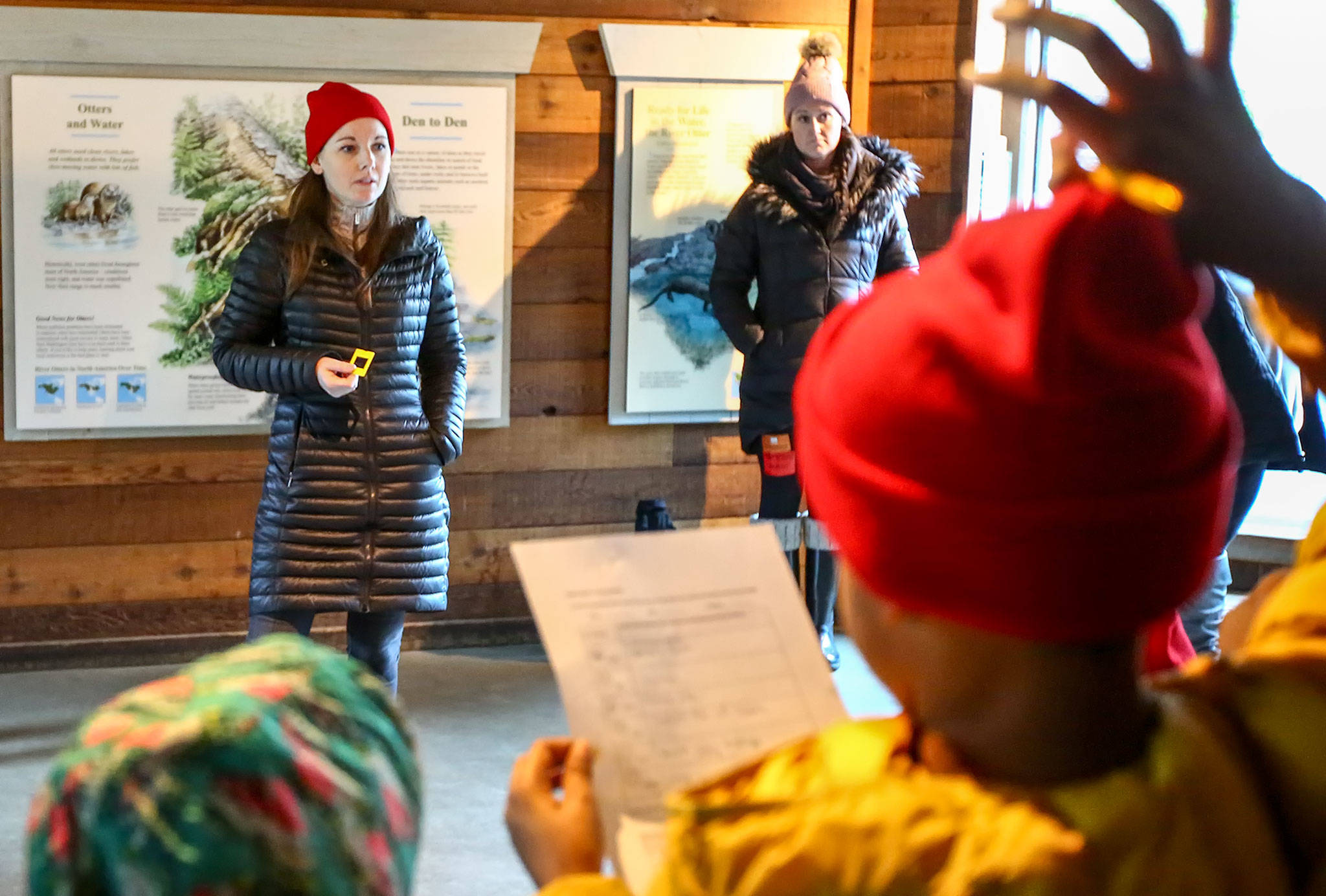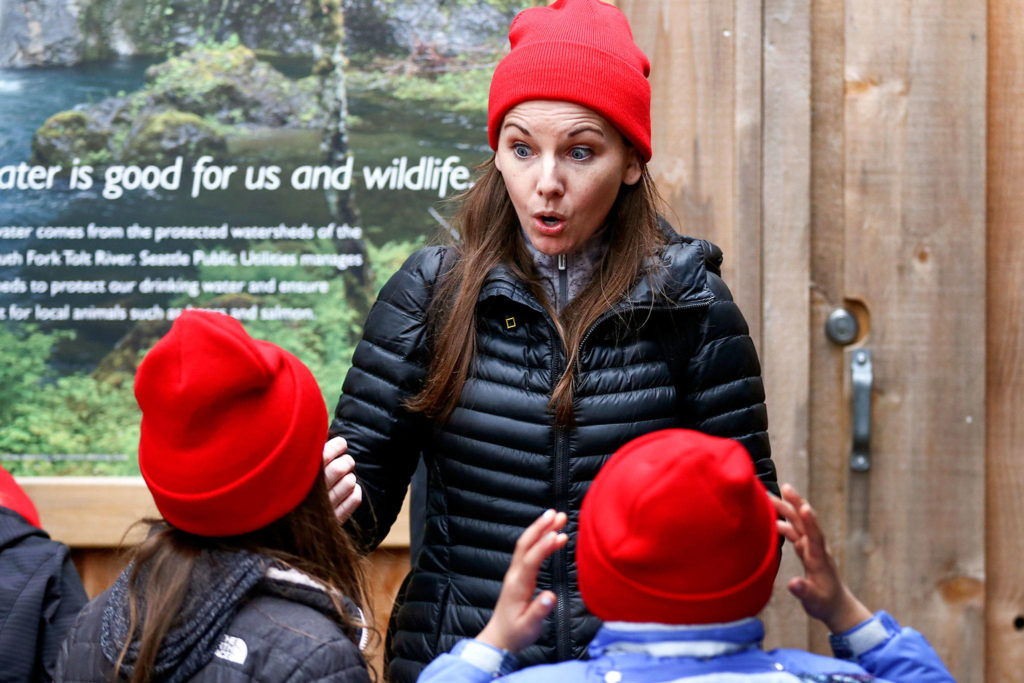LYNNWOOD — Jennie Warmouth was awestruck as she watched polar bears, weighing 1,000 pounds or more, lumbering across the Arctic pack ice.
Blue whales, 100 feet in length and weighing 200 tons, spouted so close to the ship’s bow she could hear them exhale.
During an 11-day trip to the Arctic on a National Geographic fellowship, Warmouth listened to the crackling of fresh water glaciers as they melted into the saltwater.
She was surrounded by turquoise sea water so clear she could see 60 feet into its depths.
She spotted reindeer, walruses and seals. Arctic foxes were shedding, but still retaining, patches of their thick white winter coats.
“My senses were overwhelmed,” she said. “I’ve never been in a place so pristine, untouched and wild where I felt like I was visiting habitat in which humans didn’t belong.”
Warmouth, a second-grade teacher at Lynnwood’s Spruce Elementary School, made the trip in June, co-sponsored by National Geographic Society and Lindblad Expeditions. She has taught at the school for 19 years, the same school she attended as a child.
She was one of 45 teachers from the United States and Canada chosen for Grosvenor Teacher Fellowships, sending them on trips around the globe, including Central America, Antarctica and the Galápagos Islands.
She updated a website she designed for the trip as often as the weak internet signal that comes with the remoteness of exploring an area 600 miles from the North Pole would allow. It took 25 minutes to upload just one photo.
The region she explored allowed her to see lands and seas with relatively limited human contact.
Yet signs of a larger global environmental crisis were evident in the Arctic, with its pristine water and abundant wildlife.
Far more ice had melted than typical for the time of year, affecting polar bear habitat and hunting grounds.
On one of their excursions around Spitsbergen, an island between Norway and the North Pole, a naturalist on the expedition scooped up a mitten full of debris. Pieces of boat line and an intact white plastic spoon had ridden ocean currents and washed up on a beach.
Warmouth’s mission was to find ways to share not only the beautiful images of her trip, but to demonstrate to her young students how that environment was changing and imperiled.
Spiking the Sporks
Two months after her return, Warmouth still dreamed of being in the Arctic.
“When I think about the colors, I keep trying to hold on to how I felt,” she said. “It was so vivid and exciting.”
She spent part of the summer learning to edit GoPro video that would be posted to her website, along with photos of the trip.
She began the new school year with a class of 20 second graders. She gradually began weaving stories of her adventure into their classwork.
Warmouth wanted to introduce them to some of the environmental issues she had witnessed in ways they could easily understand.
First was a trip to PAWS, the Lynnwood animal shelter, to observe six orphaned cubs. Seeing these baby bears could give them some way of imagining the life challenges faced by the distant polar bears Warmouth had seen.
At a school assembly, Warmouth shared photos of her trip, including the one of the plastics found on the Arctic beach.
The plastic utensil in the image looked familiar, similar to the plastic sporks used in the school’s lunchroom. Students wondered: Just how many of those non-reusable plastic utensils were being used — and thrown away — at the school each year?
The math was pretty simple: The sporks cost 15 cents each. Some 385 sporks were thrown out each day of the 180-day school year, costing $1,039.50 a year.
Replacing them with metal forks and spoons would cost $200, saving about $800 annually.
The class made a presentation to school principal Emily Moore. They wanted the school to stop using disposable eating utensils.
The only concern seemed to be: Is there a way to keep the school’s young students from tossing the reusable silverware into the trash, just as they, with years of repetition, had been doing with the plastic sporks?
“The Whole School Acted”
Wearing red hats like those worn by French ocean explorer Jacques Cousteau, Warmouth’s students took a field trip to Seattle’s Woodland Park Zoo in December. The goal was for them to practice observing wildlife, just as their teacher had done in the Arctic.
First stop was to see the grizzly bears, Keema and Denali.
The students stood on short steps to get a better peek at a rock where the two bears were dozing, or at least taking some quick power naps.
They were handed a piece of paper and asked to write down what they were seeing.
The two large grizzly bears occasionally yawned, opening jaws so wide they looked as if they could swallow a soccer ball in one gulp.
There was a cacophony of excitement as one of the bears briefly hoisted itself up a bit as if to get up, but then just settled back down.
Christoffer Fernandez, 8, summarized his observations this way: “They were happy and sitting and relaxing and they opened their mouths.”
“I put sleeping, yawning and happy,” said Julius Burke, 8.
Shortly after the trip to the zoo, the class learned that their idea to replace plastic with reusable lunchroom utensils had been approved.
And the way to stop students from throwing them away? Have fellow students, dressed in green vests with badges stamped Silverware Patrol, stand guard at the garbage cans. If a piece of silverware accidentally was thrown away, the students were given grabbers and reach wands with magnetic tips to hoist it out.
Students from throughout the school applied for the lunchroom duty by writing short statements on why they wanted to volunteer. Eventually, 60 were selected.
Emilio Anguiano, 11, said he was troubled by the ongoing effects of pollution.
“There are animals dying left and right, a ton of trash in the ocean,” he said. “If we don’t do something, some animals will be extinct.”
Christoffer Fernandez explained his reason with a question.
“Did you know about the great Pacific garbage patch? It’s the size of two Texas.”
The massive wad of floating marine debris, most of which is plastic, eventually breaks down into tiny pieces called microplastics that are ingested by wildlife.
The job of cleaning the reusable silverware does mean extra work for the kitchen staff, said Julie Martin, who has been at the school for 29 years.
“We used to do this,” she said with a smile, as she sorted through forks and spoons, preparing them for the dishwasher. “I don’t have any worries about it.”
Nazar Tarasiuk, a former Warmouth student now in the fifth grade, said he has an idea for how the lunchroom recycling program can be expanded.
“Maybe use real plates at breakfast,” he said. “It’s better for the school, it saves money. It’s better for the kids to have them instead of paper.”
Other schools have taken notice. Brier Elementary School started a reusable silverware program in February. More schools may join in during the upcoming school year.
“It has been her kids from the beginning,” said Moore, Spruce’s principal. “I’m really proud of it.”
The program’s impact — stopping the disposal of more than 89,000 sporks during a school year — has brought meaningful change to the school, she said.
Warmouth has shared her experiences and stunning Arctic photos across the campus, Moore said.
“The whole school learned and the whole school acted.”
Sharon Salyer: 425-339-3486 or salyer@heraldnet.com
See more about Jennie Warmouth’s Arctic trip
Videos are posted at:
Find out more about Spruce Elementary School’s switch from disposable to reusable silverware:
Talk to us
> Give us your news tips.
> Send us a letter to the editor.
> More Herald contact information.




























